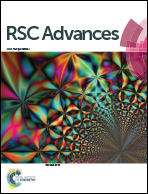Cationic and anionic reverse micelles as the molecular crowding container for G-quadruplex structure†
Abstract
In this study, we tested the feasibility of using reverse micelles (RMs) as molecular crowding containers for DNA G-quadruplex. The results suggest that the RMs formed by anionic surfactants should be avoided for the molecular crowding studies of G-quadruplex structures. In contrast to the molecular crowding condition created by polyethylene glycol, the human telomeric sequence d[AG3(T2AG3)3] shows different conformations and drug binding stoichiometry in cationic RMs. Cationic RMs allow the DNA to avoid the dehydration effect caused by polyethylene glycol, and are therefore ideal containers for molecular crowding studies.


 Please wait while we load your content...
Please wait while we load your content...